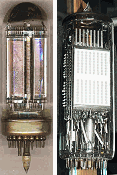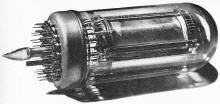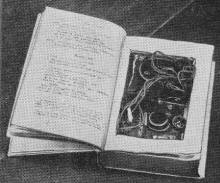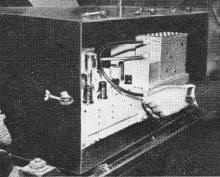|
June 1947 Popular Science
 [Table of Contents] [Table of Contents]
Wax nostalgic about and learn from the history of early
electronics. See articles from
Popular
Science, published 1872-2021. All copyrights hereby acknowledged.
|

RCA Selectron vacuum tube
Popular Science magazine, as did Mechanix Illustrated
and Popular Mechanics, included a wide variety of science and mechanics
topics in every issue - as the titles imply. Sometimes brief news reports were
used, and other time entire multi-page articles were written. In a case of the
former, this collection of items appeared in the June 1947 issue. Digital
computers were replacing analog computers due to their more flexible programming
ability and lower inaccuracies. Data storage was easily handled with magnetic
tape, but the speed of read/write operations was usually a bottleneck in the
process. Radio Corporation of America (RCA) developed what they called the
Selectron vacuum tube, which used phosphorous dots to store a charge
representing a digital "0" or "1." Operation was somewhat akin to dynamic random
access memory (DRAM) that
required periodic refreshing of the storage cell value before it fades to
obscurity. Before the Selectron could make it to prime time,
magnetic core memories were invented. Also in the report was a method the
Dutch used for hiding radios in books during World War II.
Electronics News
 Tube with a Memory Tube with a Memory
Developed to help electronic computers "remember" the factors involved in long
mathematical sequences, RCA's Selectron is expected to permit the multiplication
of two 13-digit numbers in about one hundred-millionth of a second. A screen of
tiny wires forms a checkerboard of windows through which electrons can pass to store
electro-static impulses, representing up to 4,096 mathematical factors, on a target
insulator. The tube's circuit "opens" the windows individually to receive impulses
and to release them again whenever they are required for the calculation.
 How Dutch Hid Radios How Dutch Hid Radios
When the Nazis confiscated Dutch radios in 1945 to restrict foreign broadcasts,
pocket-size receivers by the thousand were secretly turned out for the resistance
movement by workers of the Philips Research Laboratory, Eindhoven, Holland. The
one shown in the cutout portion of a book is typical of their design. Using only
one or two midget tubes, they were hidden in lamps, powder dusters and other everyday
objects. One, inside a can of vegetables, was even sent safely into a Nazi prison
camp.
 FM Aids Railroads FM Aids Railroads
This mobile FM transmitter-receiver, part of equipment recently tested on the
Southern Pacific Railroad, provides a stormproof party line for train crews and
dispatchers (PSM, April '45, p. 130). In the tests, engineers in the cabs of long
freight trains checked their orders with conductors riding in the cabooses, with
stations along the line and with San Francisco headquarters via telephone relay.
Use of the experimental equipment was reported to have saved time and trouble in
handling trains.
Posted January 15, 2024
|